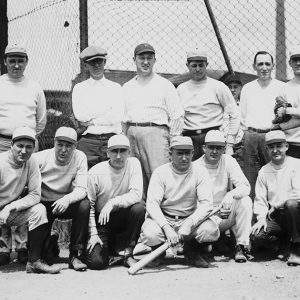calsfoundation@cals.org
Hiram Heartsill Ragon (1884–1940)
Hiram Heartsill Ragon was a Democratic member of the U.S. House of Representatives. He represented the Fifth District of Arkansas in the Sixty-Eighth through the Seventy-Third Congresses, serving from 1923 to 1933. He also served as a judge on the U.S. District Court for the Western District of Arkansas from May 1933 until September 1940.
H. Heartsill Ragon was born in Dublin (Johnson County) on March 20, 1884, to Alfred Jackson Ragon and Anne E. Heartsill Ragon. (His congressional biography lists 1885 as his birth year, but his draft card, 1900 census data, and grave stone give 1884 as the year.) He received his early education in the local common schools and at Clarksville High School. He attended the College of the Ozarks (now University of the Ozarks) and the University of Arkansas (UA) in Fayetteville (Washington County) before graduating from the law department of Washington and Lee University with an LLB in 1908. He was admitted to the Arkansas bar that same year and opened a practice in Clarksville (Johnson County). In addition to building his law practice, Ragon had a farm and an interest in the local hardware company. He soon ventured into politics, winning election to the Arkansas House of Representatives in 1910. He served two terms, acting as chairman of both the Judiciary Committee and the Constitutional Amendment committee during the second term.
In 1916, he married Mattie Smith, and they soon had a son, Hiram Heartsill Ragon Jr.
After his time in the legislature, Ragon served as a district attorney in Clarksville from 1916 to 1920. He was secretary of the state Democratic convention in 1918 and chairman in 1920. In 1920, he also attended the Democratic national convention as a delegate. In 1922, after first winning a multi-candidate Democratic Party primary in which he was reported to be the recipient of Ku Klux Klan support, Ragon was elected to Congress. He was easily reelected every two years until he resigned in 1933 to become U.S. district judge of the Western District of Arkansas.
In Congress, he served on the influential Ways and Means Committee, as well as the Committee on Insular Affairs, the Committee on Coal Mines, the Committee on Expenditures of the Treasury, the Committee on Elections, and the Committee on Territories. He was also well known as an active and enthusiastic member of the House Democrats’ baseball team.
While his political influence was at its peak after the Democratic triumph in the election in 1932, Ragon’s career in elective office ended in the early days of the New Deal when he was appointed to the U.S. District Court for the Western District of Arkansas by President Franklin D. Roosevelt on May 12, 1933; he was confirmed by the Senate that same day.
Ragon’s most noteworthy case was United States v. Miller (1939), in which he was the presiding trial judge. On appeal, the case would result in one of the Supreme Court’s first major rulings on the issue of the Second Amendment “right to bear arms,” in this case, a sawed-off shotgun. At the trial level, in response to defense requests for a demurrer, Ragon twice issued rulings in which he declared that the National Firearms Act, enacted in 1934, was a violation of the Second Amendment and its guarantee of the “right to bear arms.”
His decision came as surprise to many, because Ragon had been an outspoken supporter of gun control while a member of the House, having once declared, “I want to say that I am unequivocally opposed to pistols in any connection whatever. If you want something in the home for defense, there is the shotgun and the rifle, but a pistol is primarily for the purpose of killing somebody.” While the weapons in question were different, given both Ragon’s previous stance and his New Deal–era loyalties to the Roosevelt administration, there was speculation that the case was intended as a test case brought before a sympathetic judge in an effort to get a judicial stamp of approval on the New Deal legislation.
In the end, the Supreme Court reversed Ragon’s ruling and sent the case back to the lower courts for further fact finding. In the Court’s opinion, Justice James C. McReynolds stated clearly that the Second Amendment right to bear arms was not all encompassing, questioning whether the sawed-off shotgun at issue in Miller was reasonably related to the efficient operation of a well-regulated militia.
Ragon died suddenly on September 15, 1940, of an apparent heart attack. He is interred in Forest Park Cemetery in Fort Smith (Sebastian County).
For additional information:
Baker, James Thomas. Brooks Hays. Macon, GA: Mercer University Press, 1990.
Frye, Brian L. “The Peculiar Story of United States v. Miller.” NYU Journal of Law & Liberty 3 (2008): 48–82. Online at http://www.law.nyu.edu/sites/default/files/ECM_PRO_060964.pdf (accessed September 23, 2021).
“Heartsill Ragon” Biographical Directory of the United States Congress. http://bioguide.congress.gov/scripts/biodisplay.pl?index=R000009 (accessed September 23, 2021).
Herndon, Dallas Tabor. Centennial History of Arkansas. Vol. 3. Chicago: S. J. Clarke Publishing Company, 1922.
William H. Pruden III
Ravenscroft School
 Early Twentieth Century, 1901 through 1940
Early Twentieth Century, 1901 through 1940 House of Representatives Baseball Team
House of Representatives Baseball Team 




Comments
No comments on this entry yet.